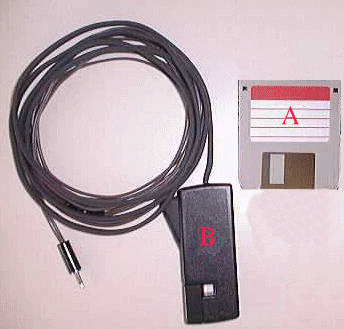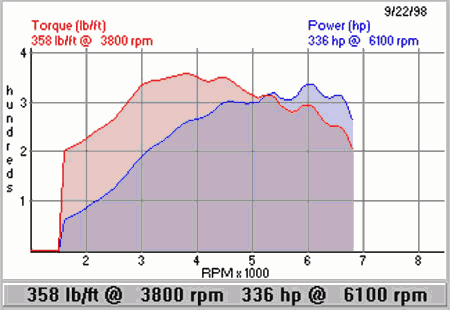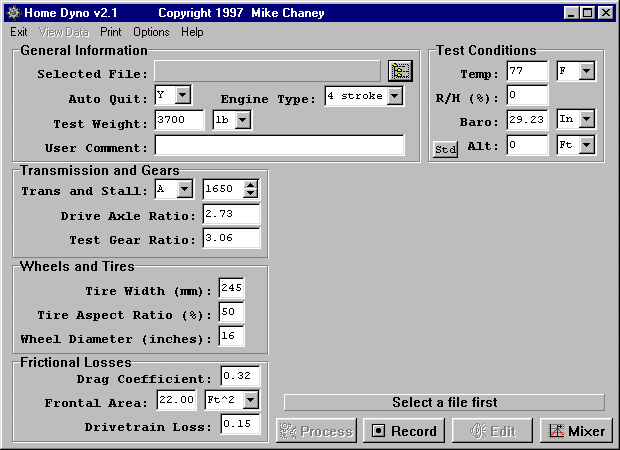|
Many of you have been just as frustrated as I when it comes to adding
upgrades to our cars and having to judge the performance by "seat of the
pants" feedback. Unless you live in Switzerland where they seem to have
more AWD dyno's than they do 7-11's in the States (hiya Roger!), you're
kinda S.O.L.
The G-Tech Pro is a nice unit and it gives you a ballpark figure of
horsepower, but it does not produce a dyno chart of torque and horsepower.
So I found myself looking for some way to peek behind the curtain and get
an idea of what was happening to the performance of my engine.
I think I found it.
Some of you may raise an eyebrow, but trust me, it works. Besides, if
you've got nothing... then something is better than nothing! :-) I ran
across this item while doing keyword searches on the Internet. It's called
the, "Home Dyno". I know... stupid name. But it really works. A
standard chassis dynamometer is basically a device that applies a
specified load to the engine via drums beneath the wheels and an inductive
pickup which attatches to the spark plug wire to measure the work being
performed by the engine under these loaded conditions.
Home Dyno substitutes the weight of your car for the drums under you
wheels. It factors in the work required to move the weight of your car,
drive axle ratio, test gear ratio, tire aspect, tire diameter, drag
coefficient, drivetrain loss, frontal area, and even the barometric
pressure, temperature, and relative humidity for those who love to brag
about their "corrected times". :-)
The way it works is you connect the supplied inductive pickup to a spark
plug wire and run the other end of the wire into the cabin where the cable
terminates in a 1/8" jack. This end you plug into either a microcassete
recorder, minidisc recorder, or (with an adapter) a camcorder. I'd
recommend the camcorder or minidisc recorder, since there are no issues
with playback vs. recording speed.

{Note: This kit is no longer available with the pickup, but only with the
software and test files. Full instructions, sources for the pickup and parts,
and diagrams for the simple circuitry are available on their website}.
Then you find yourself a nice stretch of
road and ease the car into 2nd gear, creeping along with no gas applied.
Hit record and hit the gas. Take the car up to redline and perhaps even the
rev limiter. Slow down and hit stop. Connect the recorder to the line in on
your PC's soundcard and record it as a WAV file. once the run is recorded
as a WAV file, it is up to Home Dyno to analyze the signal. With a few
mods, HKS exhaust & HKS Super Power Flo intake, I got this:

Click to see the full-size chart, 900x620
Not bad, eh? Actually it's within 1HP of what HKS predicts with these two
items fitted to the car. Here's the specs I plugged in during the analysis
portion. The drivetrain loss is taken from Roger Gerl's observations during
actual AWD dynoing in Europe. The rest of the numbers are from the
Mitsubishi service manuals.
http://www.languys.com/dave/336chart.jpg
The Home Dyno website is:
www.charm.net/~mchaney/homedyno/dynokit.htm
Here's a screen shot from Version 2.1, (the latest version is 2.3),
showing the layout and the various parameters that must be input.

I think it's a great way to get more definitive feedback on what each
performance mod does to the power of the car. Makes it feel a bit better to
drop a $1000 for an item if you can see the results on paper. If anyone has
any questions, feel free to send me some private mail and I'll try my best
to answer them all. ---
Dave Allison

Comment by Barry E. King:
Excellent information Dave.
I saw this setup a while back. There's no reason it shouldn't be accurate
given correct inputs as you appear to have done. Cool idea. One of those
"Gee, I shoulda...".
Anyway, another approach is to record the ignition on any high quality
recording device. A digital or conventional camcorder ideally with PCM
sound quality works great too. That way you avoid having to lug a PC around
in your car. Same steps as you describe except record to tape and playback
the tape to the PC to create the WAV file.
More interesting home brew dyno projects are out there too. Here's another:
http://crash.ihug.co.nz/~geoff/dyno.htm
There's also a guy in England who, given your specifications, will design rollers
and plans for your application. You'd then get the drums built
professionally and go from there. For $1000-2000 plus some software and
computer equipment you could have your very own inertial dyno. ---
Barry
|


![]()
![]()
![]()
